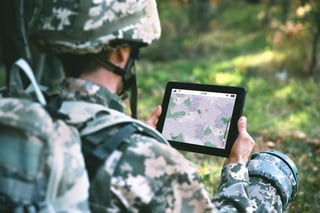How Troops Stay Connected in Remote Locations
 Military forces operating in remote or hostile environments depend on cutting-edge networking technologies in order achieve critical information superiority.
Military forces operating in remote or hostile environments depend on cutting-edge networking technologies in order achieve critical information superiority.
Warfare has evolved a great deal over the course of the last several decades, and not just in terms of the weapons and threats that have emerged in the 21st century. There is an altogether new theater in which war is being waged: cyberspace.
Access to information has always played a pivotal role in determining winners and losers on the battlefield, but in our highly digitalized era, data is increasingly becoming a powerful weapon. Strategy& describes a constant fight for what’s called information superiority — “the ability to meet the information requirements of supported [military] forces with superior timeliness, relevance, accuracy, and comprehensiveness than can be achieved by an adversary.”
Unfortunately, as Strategy& points out, “Although the benefits of information superiority are clear, the means of achieving [it] are not.” Most modern militaries — including the United States’ — have invested heavily in a variety of cutting-edge hardware and software in pursuit of information superiority. But these technologies need strong connectivity in order to be deployed, and many armies are still struggling to achieve it in remote or hostile environments.
The Challenges of Delivering Battlefield Connectivity
Unlike a standard environment in which one might attempt to build a network, soldiers need to stay connected to central command stations and other active units that are out of their lines of sight at all times. Especially in places like Afghanistan, soldiers are moving through valleys and across mountainsides, rendering standard networking infrastructure all but useless.
Militaries have historically used satellite-based communications to overcome these obstacles. While that approach will typically get the job done, it also introduces good deal of latency into the equation. When it comes to the transmission of engagement- or safety-related data, a delay of even a few milliseconds can lead to serious problems.
Non-satellite battlefield connectivity is also complicated by the demands of combat. Military networking equipment must simultaneously be portable enough to be worn or carried — soldiers already carry between 60 and 100 pounds each — and sturdy enough to make it through the rough conditions that soldiers endure on a regular basis.
What’s more, military networking equipment must contend with a great deal of radio-frequency interference (RFI), especially in places like Iraq where the open landscape necessitates widespread use of a variety of heavily-armored vehicles. Both the shielding materials and the host of other electronic systems contained within such vehicles present significant issues for data transmission.
Finally, each and every piece of military networking equipment must include robust cybersecurity protocols to ensure that critical strategic data doesn’t fall into the wrong hands. In a highly-mobile battlefield environment, it can be nearly impossible to achieve this level of security while still delivering reliable connectivity.
Kinetic Meshes: A Powerful Solution
Fortunately, in the early 2000s, the IT community started to develop technologies like mesh networks that were ideally suited for tough battlefield conditions. Originally conceived as a solution to connectivity issues experienced by first responders and isolated open-pit miners, mesh networks have now become a fixture in industries like mass transportation and oil and gas extraction.
In recent years, the most mature version of mesh networks — kinetic meshes — have helped military forces make progress in delivering reliable, secure battlefield connectivity. Unlike a traditional network, a kinetic mesh turns every connection into a node, creating a highly flexible network freed from any centralized IT infrastructure.
Instead of defining the route of a data packet ahead of time, a kinetic mesh continuously evaluates the most efficient network path for every packet to take and reroutes accordingly. If a certain node or set of nodes suddenly becomes unavailable, a transmission over a kinetic mesh will simply be redirected through the next-best path. In addition to its robust fault tolerance and low latency, a kinetic mesh delivers end-to-end 256-bit encryption of both data and metadata. Every packet transmitted over a kinetic mesh network receives a per-hop authentication, which makes it effectively impossible to intercept and decrypt messages.
The Importance of Innovation
Whether on the battlefield or in any other complex IT environment, successful networking depends first and foremost on a willingness to innovate. As Paul Hellhake, CTO of kinetic mesh pioneer Rajant, confesses, “Progress was not made until our development team made the decision to forgo conventional networking wisdom.”
At Turn-key Technologies, we’ve spent more than two decades crafting forward-thinking, unconventional networking solutions tailored to the needs of a wide variety of clients. We have the expertise needed to help businesses of any stripe achieve information superiority in their own industries here at home.




